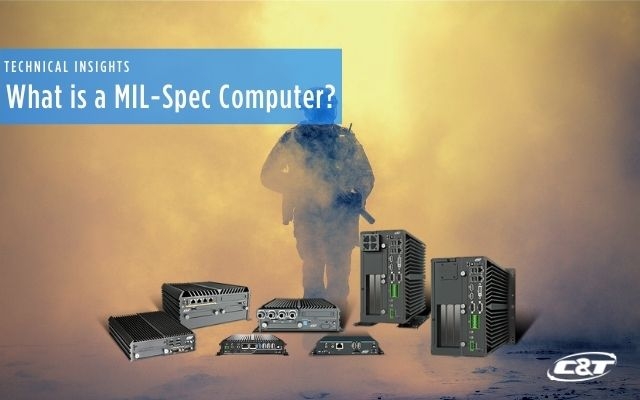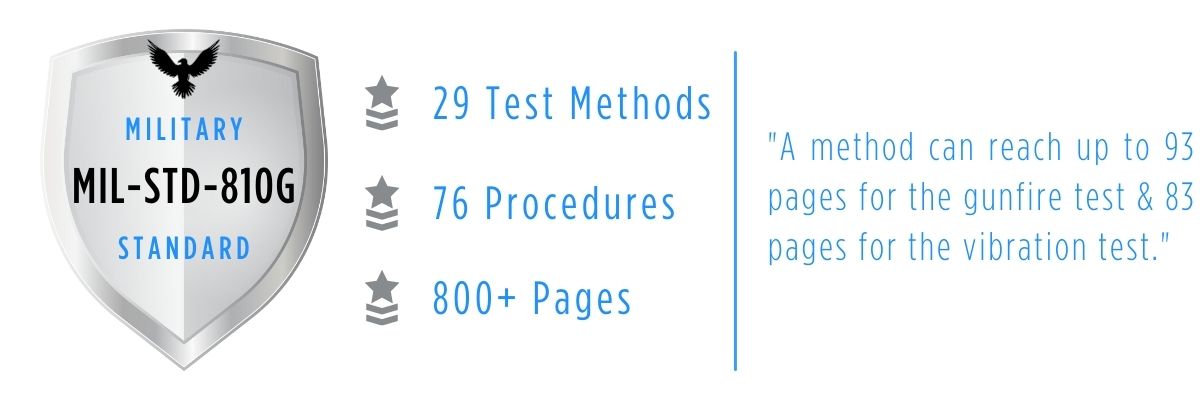What Is A Mil-Spec Computer?

Military Standard Computer - Mil-Spec PC
If you’ve been searching for rugged computers, you’ve probably noticed some solutions marketed as having compliance with Mil-Spec or MIL-STD. Manufacturers often claim their rugged computers are designed, certified, and/or tested by this standard. So, what exactly is a Mil-Spec Computer? We will answer this question in much detail below.
What is Mil-Spec and why it’s important for computers?
Mil-Spec is the standard used in the United States military forces to assess equipment’s eligibility on the battlefield. In a combat situation, equipment used by the military force is required to be extra durable and reliable to ensure the success of the mission. Most of the time, Mil-Spec component designs are owned by the government. These designs are then used by various companies to manufacture different specs and sell them to the department of defense (DoD) and its contractors. The Mil-Spec standards have very strict quality control requirements to ensure that manufacturers are implementing the right methods, procedures, and tests are tailored, for equipment to meet the military standards. When talking about Mil-Spec you might find other terms such as:
-
MIL-STD (defense standard)
-
MIL-DTL (defense detail spec)
-
MIL-PRF (defense performance spec)
-
MIL-SPEC (defense specification)
When companies talk about Mil-Spec, they are referring to the fact that their equipment meets certain MIL-STD (defense standard) methods when measuring the durability and reliability of a device when exposed to challenging conditions. One of the standards that have gained popularity is the MIL-STD 810G, which means that the rugged PC complies with MIL-STD-810 and can therefore withstand deployment in extreme environments. Compliance with the standard means that a rugged PC has been tested and validated to endure deployment in environments where the system will be exposed to frequent shock and vibration and other tests, such as exposure to heat, cold, and many other challenging environmental conditions.
What is a Mil-Spec Computer?
Mil-Spec Computer is a ruggedized computer that brings a device one step closer to becoming a military-grade device by complying with the U.S. military standards or commonly refers to as MIL-STD. Having a device that complies with the MIL-Spec signifies that the device is reliable, durable, and can survive challenging conditions for prolonged periods of time.
There are two good examples of MIL-STD compliances that are used by hardware manufacturers which are MIL-STD-461 and MIL-STD-810G. MIL-STD-461 is a standard for testing electromagnetic compatibility (EMC). Similar to FCC to MIL-STD-461 standards require very strict controls related to EMI (electromagnetic interference) and the susceptibility of devices to EMI. While MIL-STD-810 is designed to make sure the equipment can maintain its reliability, durability, and longevity in the toughest battle conditions.
What is MIL-STD-810G?

MIL-STD is a standardized testing method for environmental engineering considerations and laboratory tests. It tests equipment to the limit within conditions that will be experienced by devices throughout their entire service life. MIL-STD utilizes the testing facilities with chamber test machines to replicate realistic environments' effects on materials, instead of just imitating the environments themselves. MIL-STD-810 is a very comprehensive test, methods, and procedures that consist of 29 test methods and 76 procedures that make up approximately 800 pages, and a method can go up to 93 pages for the gunfire test and 83 pages for vibration test. Additionally, the letter G is used to indicate incremental changes including an update to an older method, adding a new method, and/or revisions of the previous version. That said, MIL-STD-810G is designed to provide high confidence in devices.
What Does Compliance with MIL-STD-810G Really Mean?
Unfortunately, there are no strict rules of conduct to govern the legitimacy that can guarantee military-grade quality equipment when a manufacturer decides to market their products complying with Mil-Spec or MIL-STD standards. There are several possibilities of complying with what MIL-STD actually means.

First, to comply can mean that the manufacturer might just implement an architectural design that is based on the MIL-STD standards without doing any tests to ensure the endurance of the products themselves. This can bring up potential problems if you are really looking for a device to be deployed in an extreme environment.
Senond, complying with MIL-STD-810 can refer to the manufacturer who had designed and tested the equipment in a testing lab. This indicates that the equipment was tested and measured to verify the product’s quality to comply with the MIL-STD-810.
However, there is a flaw, despite reaching numbers and benchmarks within the MIL-STD-810 papers, the products wouldn’t be able to be accepted by the U.S. Department of Defense (DoD) for real military usage. Therefore, these kinds of manufactures can only fully cover the non-military usage market. It’s very complicated and expensive to create a lab facility that is approved by the DoD.
The third case is, the company tested its equipment in an in-house accredited lab, third-party accredited lab, or testing in the presence of a DoD inspector. Thus, the company is completely verified to comply with MIL-STD-810 and can provide their products for military uses as well. A company that has the means to gain a military contract is the one that invested more for the tests and facilities to comply with DoD standards. That said, the second and third ways are both having the highest warranty to comply with the MIL-STD-810G. Note that it’s important to do further research on MIL-STD compliance products. Ask questions such as, which test methods did they use, how are the procedures conducted, and how are the tests being tailored. More importantly, as for the copy of the test report to personally assess the tests in detail and reduce the risks of bad quality products.

Why Embedded Computers and Edge Computers can Benefit from MIL-STD?

Organizations and businesses that deploy Embedded computers and edge computers are deployed for their reliability in performance and their durability to withstand challenging conditions in extreme environments. Industrial computer manufacturers vigorously challenge their computers to meet stringent MIL-STD specifications to ensure their computer’s reliability, durability, and longevity. Therefore, manufacturers that utilize the military-grade standard MIL-STD-810G can execute strict standardized tests that can realistically replicate extreme environmental and measure their effects on the materials. That said, when a computer complies with the MIL-STD-810G, it represents a durable and reliable high-quality computer that can withstand harsh environments such as extreme temperature, water and dust particles ingress, and shock and vibrations. This means it can guarantee performance in tough industrial conditions. This will benefit the manufacturers as well where they only need to design and test their device to comply with MIL-STD810G to warranty high-quality products that can survive anywhere from military deployments to industrial deployments.
In total there are 29 test methods in MIL-STD-810-G that represent a wide range of environmental conditions that exist in highly extreme environments including, altitude tests, extreme temperature range, sand and dust resistance, salt fog corrosion resistance, shock, and vibration endurance. One of these methods that Premio’s computers are complying with within the MIL-STD-810G standards is on shock and vibration endurance. Shock and vibrations are vital factors amid industrial deployments because ordinary devices can easily fail when exposed to shock or vibrations. For instance, edge computers that are deployed in vehicles will require the ability to maintain their performance while facing shock and vibrations generated from the moving vehicle. The autonomous vehicle is the future of cars and vehicles that are dependent on its computer’s reliability and durability. The risk of downtime is not a choice for an autonomous vehicle as it can result in the death of passengers or others on the road. Therefore, it’s important to equip vehicles with the most reliable and durable computer when facing a harsh environment, and MIL-STD can help to ensure the PC’s performance and confidence amid deployment.
MIL-STD-810 Key Design Features | Shock & Vibration?

In order to understand how well can a PC withstand extreme shock and vibrations there are several essential key design features that can look into in a rugged industrial PC.
First, look for a fanless computer, a fanless computer provides many benefits not only for countering shock and vibrations. Without a fan, there are various benefits brought to the computer including, extending its MTBF (mean time between failure), eliminate noise, and increase ingress protection without venting wholes. Instead of a fan, a computer can use passive cooling to cool down the system.
Second, to eliminate more moving parts you want a computer with a cable-less design. The cable-less design brings several benefits as well such as, getting rid of cable routing and cable matching problems, preventing cabling signal degradation and latency, and providing a cleaner design for the system.

Third, a computer with a one-piece design is always recommended. One-piece design is a design that molded the chassis into one piece to create a robust structure with fewer joint parts and screws that will support higher shock and vibration tolerance.
The fourth and the last one is you want a computer with industrial-grade components to ensure both outside and inside components are adopting industrial-grade parts such as a capacitor, power choke, resistors, and many more. That said, by evaluating all of these factors when choosing a rugged industrial PC, you can guarantee your computer’s reliability, durability, and longevity.

